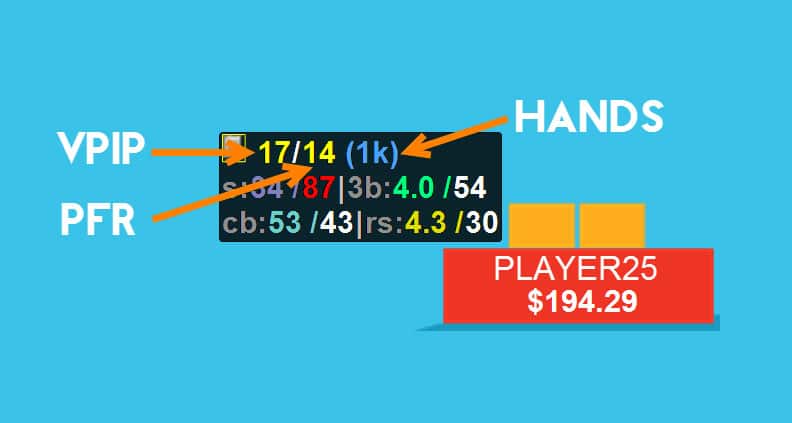This episode is specific and nerdy. Online players listen up. In this episode, James “SplitSuit” Sweeney will teach you how to make optimal decisions vs. isolation raises from opponents by turning their HUD stats into a range. Online players should not miss his tips on which stats to focus on, and how to build an accurate range from them.

As we’ve mentioned in previous podcasts, the HUD is a pretty necessary piece of equipment, so if you haven’t gotten that far, check out our software recommendations and get hooked up.
Isolation Raise Ranges
The spot we are putting under the microscope in this week’s podcast is this: What is our opponent’s range when they isolation raise us?
An isolation raise is when a player raises one or more limpers. In this way, it is distinct from an open raise, which is raising when folded to.
We see this all the time. What can we learn by studying this spot off-table?
Pre-flop ramifications — Understanding what you should do. Call? 3-bet? Fold? Once you understand their range then you can choose your own strategy and range must easier.
Post-flop ramifications — If you 3-bet and get called, what are they likely to have called that 3-bet with?
These are just some of the reasons why hand reading is everything.
A Note on Sample Size
In a way, sample size is the king of stats. While in and of itself we learn nothing of our opponents’ play, every other stat must be viewed in light of sample size.
Some stats like VPIP and PFR are sampled every hand, while more specific stats like Fold vs. C-Bet are only collected in rare occasions. (New to HUD stats? We wrote this HUD stat primer for you.)
Always pay attention to sample size. When sample sizes are small, stats can be fairly meaningless. As sample sizes grow, statistics become indicators of possible frequency tendencies. Only until sample sizes are large can we say with any measure of certainty that a player clearly exhibits frequency weaknesses to exploit. And even then, our information is never perfect. (Don’t get caught up trying to play perfect poker.)

HUD Stats to Look At
In the specific situation where we are isolation raised and trying to discern what range our opponent holds, we are going to be looking most specifically at these HUD stats (in the context of their sample size):
- VPIP
- PFR
- RFI
- PFR by position
- Limp behind
- Raise with Previous Limpers
To explain beyond the basics:
Raise with Previous Limpers – This tells you how often opponent raised given the opportunity, when there were limpers in front of them. If this is high, you know they isolate a lot. If low, they iso rarely. Iso rarely, tight range. Iso wide, wide range. But keep sample size in mind, and don’t get carried away if it’s small.
Limp Behind – This stat is really useful, especially when compared to the Raise with Previous Limpers stat. You can see if they’re a passive limper, a nit that’s only raising and rarely limping behind, or a loose-passive player that’s playing more fit-or-fold on the flop. Using both spots in tandem, you can determine how wide the range is, and whether or not it’s capped.
PFR by Position – Allows you to say, “how often are they raising from X position”, giving you a more position-specific read on their range.
RFI (Raise First In) – If they have low RFI, they are generally not going to be isolating as much.
Use all stats in context of the whole HUD profile, not just picking out single stats.
And remember, you can use VPIP/PFR to estimate more specific stats if you don’t have much of a sample size on them.
Putting it Into Practice
“If you’re playing in a game with a lot of regs, this is the kind of analysis I’d do off the table,” Sweeney said. “Then I’d break apart their general style.”
He suggested working on ranges off-table in software. This is cumbersome and tough to do in real-time, but if you analyze hands off-table, you’ll be able to run through “what did they isolate with?” vs. their HUD stats. Practice makes perfect.
What you’re trying to do is estimate the width of the range, which types of hands are in the range.
Width is about what percentage of hands is this person raising with. 10%? Maybe Raise with Previous Limpers is 10% with a good sample size and you can say that with confidence.
Ok, what does that look like? Open up Equilab or Flopzilla and put in top 5%, 10%, and 20%.
Now you can not only determine what they have, but now you can ascertain whether you can 3-bet and get a fold. This is how you find out when you can lite 3-bet… because you know what frequencies look like in ranges.
If you’re new to this, look at the last few times you isolated. Now, instead of looking at your cards, write down the range you would make that iso range in that spot with. Then plug it into Flopzilla and see how wide it is.
For example, if you see you iso 10% of the time here, then you can identify what someone else is using as a range when they are iso 10% of the time.
If you want to become even more of a hand reading ninja, read Sweeney’s “Laws of Hand Reading” or check out his advanced Hand Reading Lab.
And don’t stop at assigning a range. Always think about what kind of range you should use.
Put it all together and bring it to the table with the intuition to spot the iso raise and immediately put a player on a range. This is what off-table study is all about.
Sweeney challenges listeners to studying to mess around with hands and ranges for 20 minutes per day. You’ll be amazed at how quickly you can find more spots to profitably 3-bet isolation raises. He guarantees you will find 2 or 3 of these spots in your next session, as long as you put in the serious study work.
His free webinar on January 28th will be an incredible value for those who register in time.

cool points especially about how aware is the isolator. thanks for the tips – peace.
…and therefore, how wide is their range.